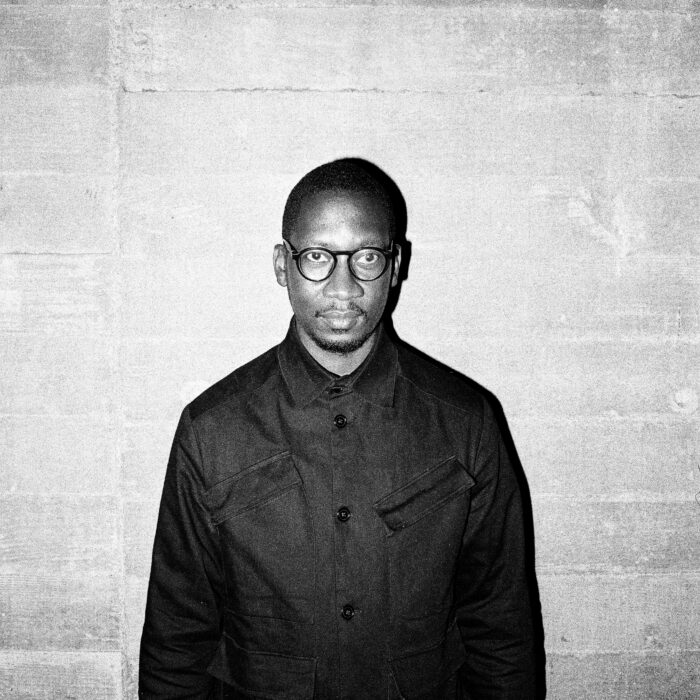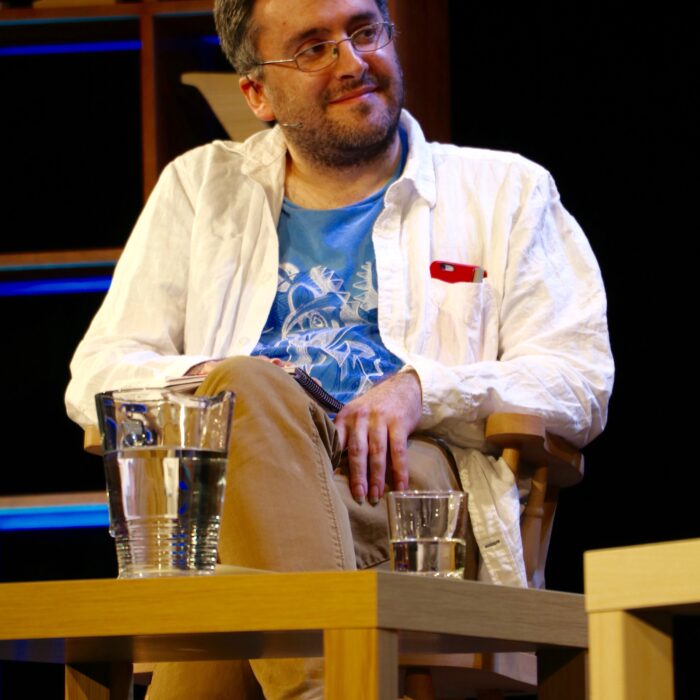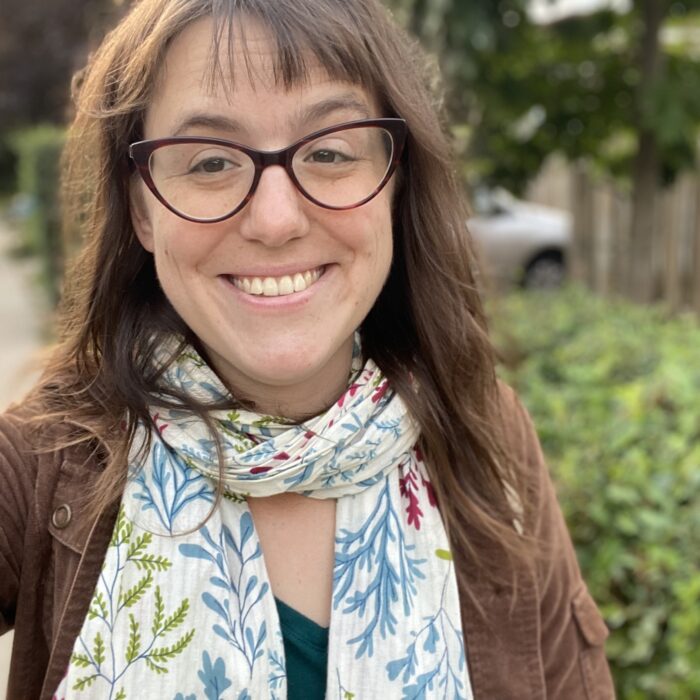You have no items in your cart. Want to get some nice things?
Go shopping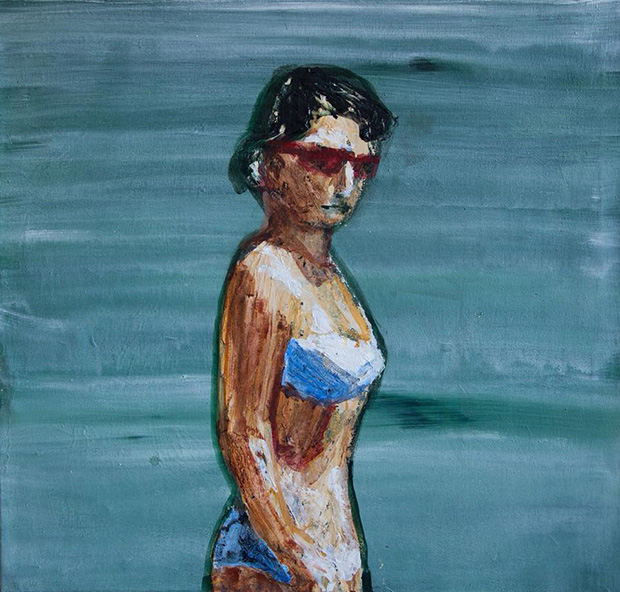
If Goya were alive, dividing his time between Harlem and Hoboken, this is what he might be painting today. I’m talking about Goya’s later Pinturas negras, not the earlier portraits of nobility he did to pay the bills. Gloria Pacis’s paintings are by turns haunting, tortured and beautiful. A sunny painting of a woman in dark glasses and a swimsuit, called simply Barcelona, recalls the beauty of that city of seven beaches, as well as the danger of the place where pickpocketing is the local sport.
Pacis, however, seems to be unaware of the edginess of her paintings and for this makes the works all the better. She isn’t trying to hitch a political hot topic to her art or lose viewers with buzzwords. She is first and foremost a painter and her art explains itself. I was surprised when she told me during a recent interview at her studio in the Monroe Arts Centre, a space she shares with the artist Ed Tadiello, that she wants her paintings to show the connectedness between people. And on second examination, this is what her paintings do. Even as they depict policemen standing on a New York street corner––a visitor to her current Artists of Asia show in the Bethune Center in Jersey City told me he found it hard to tell if the policemen were “smiling or sneering.” Or a bartender staring at the viewer, waiting for your order. Or a woman in Moscow standing in Red Square (which Pacis visited on her way back from a recent trip to Europe). All her paintings seem caught between this moment of confrontation and quiet contemplation. There are also interesting things going on with texture, light drizzles of watery paint over heavy impastos which aren’t always visible in photos of her work.
Litro: What do you feel about the expression Woman Artist?
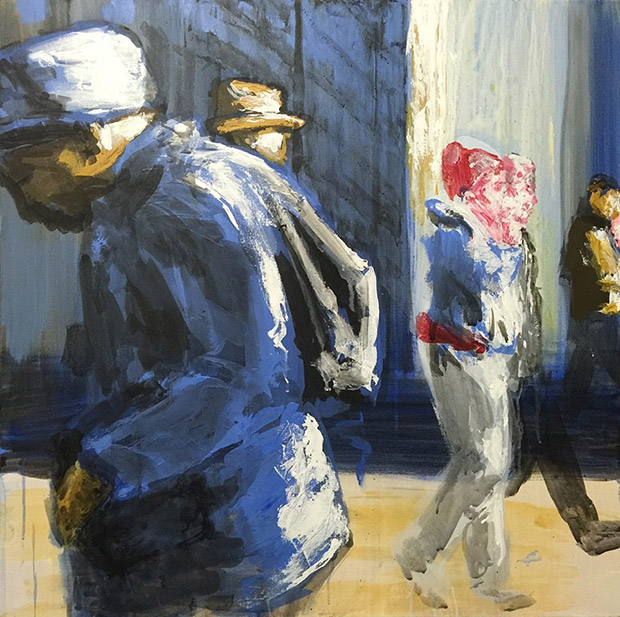 Gloria Pacis: When I’m painting I don’t think about gender. When I’m doing artwork, it’s about the only time I get to forget that I’m a woman, that I’m Asian, and I belong to a certain social class. These things that define me in my waking life disappear when I’m painting. In a certain sense, figurative artists – which is what I am – at the moment of painting become the person they’re painting. I mean, they have to empathise with the person in order to capture an expression, a mood, so that’s why I feel distinctions of gender disappear. Art is a very democratic medium despite the balance of power being somewhat unfairly tipped towards men. But I think you’ll find that’s mainly in the museum setting. Galleries show a more even balance of women and men, and I’m fortunate to have established relationships with women curators who’ve championed my work.
Gloria Pacis: When I’m painting I don’t think about gender. When I’m doing artwork, it’s about the only time I get to forget that I’m a woman, that I’m Asian, and I belong to a certain social class. These things that define me in my waking life disappear when I’m painting. In a certain sense, figurative artists – which is what I am – at the moment of painting become the person they’re painting. I mean, they have to empathise with the person in order to capture an expression, a mood, so that’s why I feel distinctions of gender disappear. Art is a very democratic medium despite the balance of power being somewhat unfairly tipped towards men. But I think you’ll find that’s mainly in the museum setting. Galleries show a more even balance of women and men, and I’m fortunate to have established relationships with women curators who’ve championed my work.
Litro: Do you feel a member of a group of women artists? How does that sit with you?
Gloria Pacis: I don’t know. Painting is pretty solitary. It’s not a group activity. But if talking about it in those terms helps get interesting women painters the attention they deserve, some attention is better than nothing.
Litro: That reminds me of something Joyce Carol Oates said to me in a recent interview. I asked her about what she thought of the expression Women’s Writing. She said, ‘It does seem patronising, since there is no Men’s Writing. But perhaps some attention is better than none. I am undecided– attitudes toward this subject have evolved over the years and are not fully defined even now.’
I feel similarly ambivalent about the idea Women’s Painting––we aren’t a homogenous whole, are we? And yet this fall I’m in a two-person show on the theme of Chinese Women Artists. Is the fact of being a woman more important than being an artist?
Gloria Pacis: I’ve exhibited in ‘Asian’ art exhibitions, notably at the Wing Luke Museum, and currently at the Bethune Center, and it’s an interesting context, although I feel in many ways my art is more inspired by the European and American traditions. I live in America, I was born in America, but because of the way I look (my ethnic origins are mixed Chinese and I look full-blood Chinese) I’ve participated in a number of shows. No one has ever invited me to participate in an exhibition of ‘American’ painters, and that’s interesting to me. The ethnic make-up of America has changed drastically to the point that in California Latinos now make up the largest ethnic group, but the images that get reflected back to us through TV and movies paint a different picture. I don’t know what’s up with TV producers (my boyfriend is a painter who also does scenic art for television), but it’s like they’re living in a delusion in which they think the whole world is white. It’s like they’re in denial. I can’t remember the last time I saw an Asian in a leading role in a movie.
Litro: Your boyfriend is the artist Ed Tadiello. He’s known for his photorealist paintings of pin-ups and angels. Your art occupies almost the opposite end of the spectrum in terms of style and portrayal of women.
Yeah, but when we exhibit side-by-side people sometimes come up to me and say they think we’re alike. We approach art in different ways, that’s for sure. I try to get to this raw place where I feel a painting boiling up within me and try to get it painted all in the same day. I’ll add touches later, sure, but it’s very much about feelings for me. Ed is a professional with everything he does – and he can paint quickly too – he does portraits of groups that he has to complete in a few hours, but his background in film and television work and the precision that requires definitely shows in his paintings. Since I’ve known him, I’ve looked at my work in a new light and taken more care with finishing paintings. And he’s loosened up a little. We inspire each other and that’s what I guess I want to say about the difference between the sexes. There’s no fixed lines. We’re all connected.
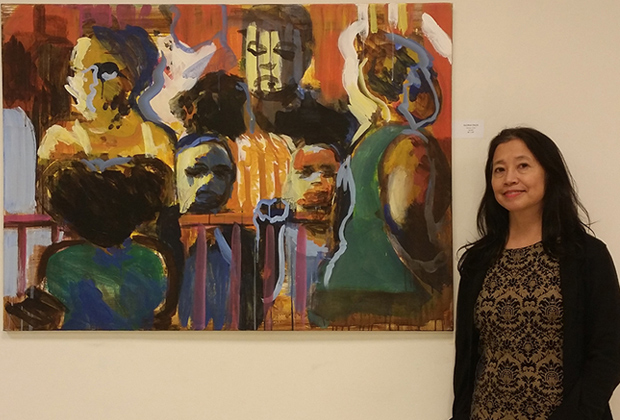 Gloria Pacis (born 1953 in Seattle) is a painter dividing her time between New York City and Hoboken, where she has her studio. She received her BFA from the University of Washington in 1976. She credits her years working as a set designer and scene artist for the dramatic, character-based elements of her paintings. She has participated in group exhibitions at public institutions and universities, including Wing Luke Museum, Henry Art Gallery, and Seattle Center Art Museum, where her work was chosen to showcase International Women’s Day. She has designed set for many leading theatres, including notable productions of A Christmas Carol, Hamlet, The Doctors Dilemma, Hedda Gabler, and Salome.
Gloria Pacis (born 1953 in Seattle) is a painter dividing her time between New York City and Hoboken, where she has her studio. She received her BFA from the University of Washington in 1976. She credits her years working as a set designer and scene artist for the dramatic, character-based elements of her paintings. She has participated in group exhibitions at public institutions and universities, including Wing Luke Museum, Henry Art Gallery, and Seattle Center Art Museum, where her work was chosen to showcase International Women’s Day. She has designed set for many leading theatres, including notable productions of A Christmas Carol, Hamlet, The Doctors Dilemma, Hedda Gabler, and Salome.
While Pacis’s paintings have a dark mood showing figures in conflict with themselves, English photographer 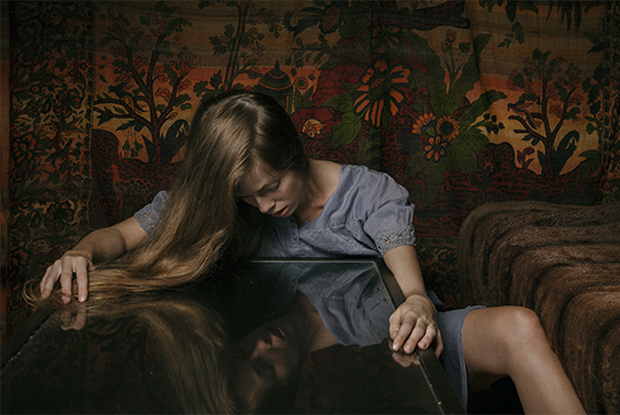 Laura Stevens makes darkness visible in strongly-posed, dramatic pictures where inner conflict is given a cinematic quality. Since receiving her Masters from Brighton University, Stevens has been living in Paris, publishing her photographs in Le Monde, The Times (UK), and The Washington Post, among others. I first saw her work a few years ago and was struck by its strong narrative force and edgy romantic quality which addresses relationships and alienation head on.
Laura Stevens makes darkness visible in strongly-posed, dramatic pictures where inner conflict is given a cinematic quality. Since receiving her Masters from Brighton University, Stevens has been living in Paris, publishing her photographs in Le Monde, The Times (UK), and The Washington Post, among others. I first saw her work a few years ago and was struck by its strong narrative force and edgy romantic quality which addresses relationships and alienation head on.
Litro: Tell me about the series Another November.
Laura Stevens: Following the ending of a significant relationship in my life, an undoing began. Whilst adjusting to being a single woman, I started to create a photographic narrative based on the experience of losing love; directing other women to portray the gradual emotional and circumstantial stages, along the well-trodden track of the broken-hearted.
Litro: As with your previous series, Alone/Together, narrative structure seems to play an important role.
Laura Stevens: By constructing images of the evolving chapters, I was allowed a vantage point from which to view the changes occurring in me, from feelings of pain, confusion and loneliness towards the reconstruction of my identity as an individual.
Litro: How do you choose your subjects?
Laura Stevens: The series of staged performances by different women, who are friends or those I had been drawn to from the street, are enacted to show an intimate moment of adjustment. They are seen isolated, surrounded by textures, colour and empty spaces in a room of their home in Paris.
Another November is situated in a deliberately nostalgic present where memories are constructed and irrevocably discolour, looking back to a past not yet acquainted with loss. Yet, it is a reminder that time, the arranger of all things, moves only in one direction.
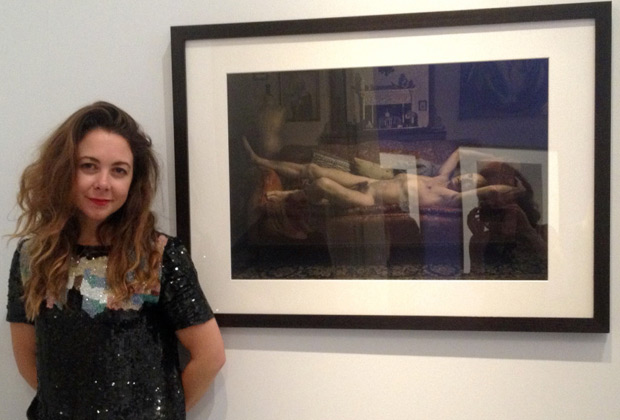 Laura Stevens (born 1977 in England) is a photographic artist living in Paris. She received her BA from Leeds Metropolitan University, before furthering her studies at the University of Brighton receiving a Master’s in Photography in 2007. Stevens has participated in group exhibitions at institutions including The National Portrait Gallery, The Centre for Fine Art Photography, Encontros da Imagem Festival, the Singapore International Photography Festival with a solo show at The Latvian Museum of Photography. Her work is represented in private collections. Laura received a special distinction in the LensCulture Emerging Talents 2014, shortlisted for the Aesthetica Art Prize 2015 and was nominated as a finalist in the PHPA (Photo d’Hotel Photo d’Auteur) 2014 and in The Taylor Wessing Portrait Prize 2013/2014.
Laura Stevens (born 1977 in England) is a photographic artist living in Paris. She received her BA from Leeds Metropolitan University, before furthering her studies at the University of Brighton receiving a Master’s in Photography in 2007. Stevens has participated in group exhibitions at institutions including The National Portrait Gallery, The Centre for Fine Art Photography, Encontros da Imagem Festival, the Singapore International Photography Festival with a solo show at The Latvian Museum of Photography. Her work is represented in private collections. Laura received a special distinction in the LensCulture Emerging Talents 2014, shortlisted for the Aesthetica Art Prize 2015 and was nominated as a finalist in the PHPA (Photo d’Hotel Photo d’Auteur) 2014 and in The Taylor Wessing Portrait Prize 2013/2014.
In contrast to the quietly romantic photographs of Laura Stevens, the dreamlike drawings and oil paintings of Chinese artist Wang Jojo exhibit a frank sexuality of which her Parisian gallerist, Sylvie Bailly, says, “we still are not accustomed to in the West”. Her works are the subject of a two-person show on contemporary Chinese women artists (full disclosure: I am the other artist in this two-person show). Jojo says there is a significant divide between what the West and East consider sensual. In China, “it’s not the case that everything has to be on show to be ‘sexy’. The way the wind catches a garment (the name of the upcoming exhibition is China Wind) and reveals glimpses of the woman underneath––that’s sexy.”
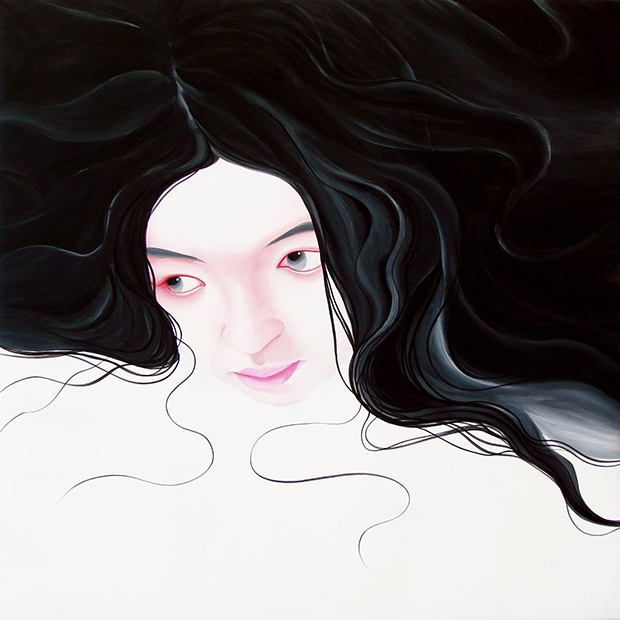 Born in 1981 in Shenyang, China, Jojo came to France in 2006 to study drawing and painting. She credits this distance with giving her a more objective view of contemporary China. Since moving to Paris in 2010, alongside her erotic works full of sexual symbolism for which she is perhaps better known, she has painted more traditional paintings populated with vividly-costumed figures reminiscent of the Chinese opera.
Born in 1981 in Shenyang, China, Jojo came to France in 2006 to study drawing and painting. She credits this distance with giving her a more objective view of contemporary China. Since moving to Paris in 2010, alongside her erotic works full of sexual symbolism for which she is perhaps better known, she has painted more traditional paintings populated with vividly-costumed figures reminiscent of the Chinese opera.
Litro: What do you think of the label Chinese Woman Artist?
Wang Jojo: Chinese women artists are often sensitive. They have traditional values, but also the spirit of resistance. Everyone has their own style. Just like the garden, every flower has its own fragrance – each artist has her story.
Litro: For you, what does it mean to be a woman working in art today?
Wang Jojo: Contemporary women artists are often courageous, open. They have the spirit of innovation, they seek freedom, they express themselves emotionally. They do not succumb to the pressures and constraints of family and company.
Litro: Do you think there is more sexism in France than in China?
Wang Jojo: In my experience, I find that compared to many cities in China, Parisian society is more open and compassionate towards women. As a woman artist, in Paris, I feel more free and I have more chances to express myself. But sexism exists in many countries. To eliminate it, finally, we each need to make an individual effort.
Gloria Pacis shows at the Bethune Center in Jersey City until August 15. Catch her also at Monroe Arts Centre during the Hoboken Art Tour, August 31. www.artofgloriapacis.com
Laura Stevens was recently selected a finalist in the Aesthetica Art Prize for her photograph Sofia (pictured), which was featured in the anthology Future Now. More of her work can be seen on: www.laurastevens.co.uk
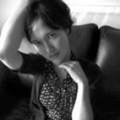
About Mia Funk
Mia Funk, Mia has received many awards & nominations, including a Prix de Peinture (Salon d’Automne de Paris), Thames & Hudson Pictureworks Prize, Sky Arts Portrait Artist of the Year, KWS Hilary Mantel Short Story Prize, Doris Gooderson Prize, Aesthetica Magazine's Creative Works, Momaya Prize & Celeste Prize. Her paintings have been featured on radio and television, at group shows at the Grand Palais, and are held in several public collections, including the Dublin Writers Museum. She is currently working on portraits for the American Writers Museum, completing a novel and a collection of linked short stories.

